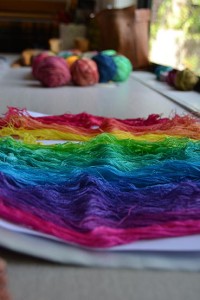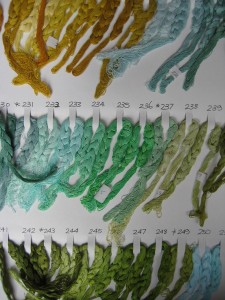Ramping up my dye book
 Dyeing is so relaxing and cathartic. It’s so easy and produces the most amazing colours normally not available anywhere. When the Online guild were running a Precision dye workshop with Margaret Coe this month I jumped at the impetus to update and re-work my dye book and learn even more about my dyes and their possibilities.
Dyeing is so relaxing and cathartic. It’s so easy and produces the most amazing colours normally not available anywhere. When the Online guild were running a Precision dye workshop with Margaret Coe this month I jumped at the impetus to update and re-work my dye book and learn even more about my dyes and their possibilities.
I’ve been using Drimerene K dyes for a long time and I’ve gotten to know the quirks of the dyes…their weaknesses and strengths.As fibre reactives for cellulose fibres they are fantastic. Although Procion dyes seem to be popping up everywhere I don’t use them very often because I need to reserve the dye solutions for future use. Procion are only effective when in fresh stock solutions. This may suit many people but is a disadvantage to me.
 The Precision dye workshop is based on exploring the primary palettes in a dye set to produce a range of secondary and tertiary colours. We’ll also mix Tri-chromatics. It’s a paint mixing exercise! My previous dye books focus on how different strengths of dye produce different shades. I also used small amounts of black for toning which can soften colours without becoming dim and murky. It’s a great resource and I recommend the possible hassle in compiling it.
The Precision dye workshop is based on exploring the primary palettes in a dye set to produce a range of secondary and tertiary colours. We’ll also mix Tri-chromatics. It’s a paint mixing exercise! My previous dye books focus on how different strengths of dye produce different shades. I also used small amounts of black for toning which can soften colours without becoming dim and murky. It’s a great resource and I recommend the possible hassle in compiling it.
I guess too, because of this previous experience, which I remember in a very hot December with my children only just avoiding pots of dye everywhere, I was able to have a lovely controlled, organised and small dye run this time.
How to control a sample dye environment
It’s not for me to eludicate the perfect example of control in dyeing but the process worked out with a minimum of mess and fuss.
For these types of dye samples you need skeins of yarn. I’ve worked out how many turns of my mill produces 1 gram of mercerized cotton. A great in front of TV job because you need alot.
With such small skeins each can be dyed in small convenient containers such as plastic cups. Line them all up ready for dyeing.
Work out the dry weight of your dye run, then mix the correct amount of water, salt and soda in a container. Then pour the correct amount of this liquid for 1gram in each of the cups. In my case I used 30ml in each dyebath cup. A very mini and cute dyebath.
Then add the dye. Yes the amount of dye solution will be teeny, so I used 1ml syringes to dispense it. But as all the dyes required a maximum of 1ml dye it was super easy to administer portions of one dye or another in the incremental measure on the syringe.
If your dye book needs re-vamping or ramping up now is the time.

Your dye book is amazing! Such an inspiration for me.